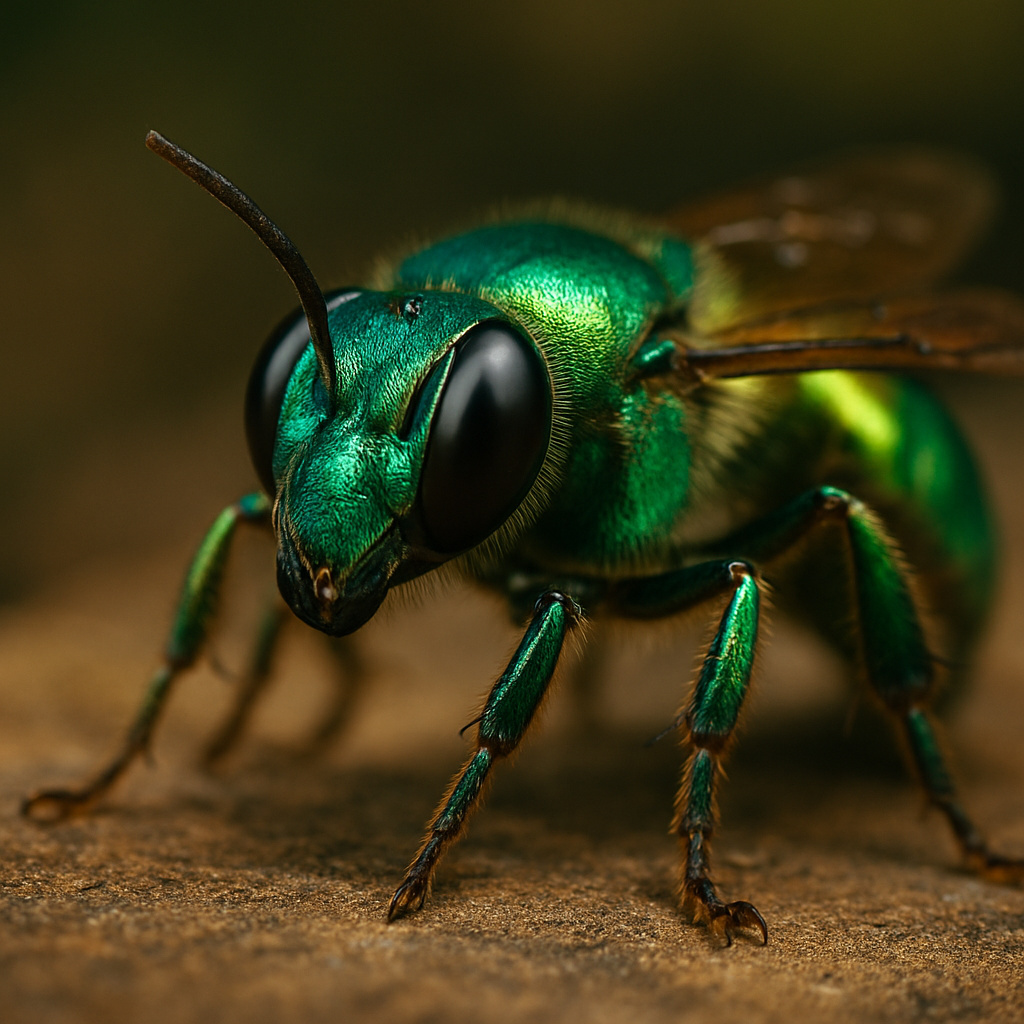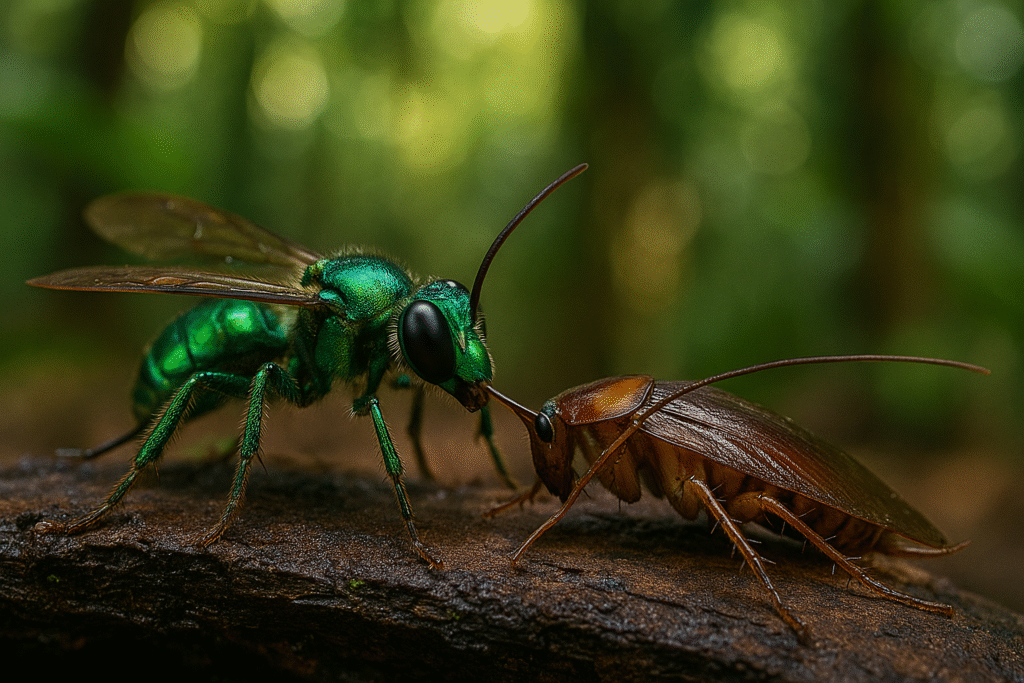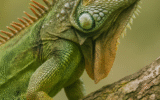A Creature That Shines Like a Gem
In the dazzling catalog of Earth’s insects, few command as much fascination—and discomfort—as the Jewel Wasp (Ampulex compressa). At first glance, it could be mistaken for a wandering fragment of emerald or sapphire, glimmering in tropical sunlight. Its exoskeleton shimmers with metallic blues, radiant greens, and flashes of copper. To human eyes, it is one of nature’s treasures, a jewel crafted in miniature. But the brilliance of the Jewel Wasp conceals a secret that is darker, stranger, and far more extraordinary than its appearance suggests.

Where butterflies enchant with their flight and beetles impress with their strength, the Jewel Wasp enthralls because it is both artist and executioner, scientist and sorcerer, healer and destroyer. It is an insect that has turned its beauty into camouflage and its intelligence into a scalpel, carrying out one of the most astonishing and unsettling survival strategies in the animal kingdom.
The Ritual of the Sting
The Jewel Wasp’s story begins not with its colors, but with its weapon: a stinger fine as a needle, sharp enough to pierce armor, and precise enough to target the nervous system of another creature. Its chosen victim is the cockroach—an insect known for its resilience, speed, and refusal to die. But even the cockroach, so often portrayed as indestructible, becomes nothing more than a stage in the wasp’s chilling performance.
The attack is carried out in two calculated strikes.
- The first sting lands in the thorax, temporarily paralyzing the cockroach’s forelegs. The victim, startled but not dead, is slowed, robbed of its ability to run.
- Then comes the second sting, one of nature’s most remarkable acts of biological precision. The Jewel Wasp inserts its stinger directly into the cockroach’s brain, delivering venom to a very specific region: the part that governs escape reflexes.
And then—silence.
The cockroach is alive, unharmed in the conventional sense, but its will has been stolen. It does not run. It does not fight. Instead, it waits.
The Jewel Wasp then does the unthinkable: it leads the cockroach by its antennae like a leash, guiding it into a dark burrow. What was once a creature of stubborn vitality is now a puppet, dancing on strings of venom.
Transformation into a Living Cradle
Inside the burrow, the Jewel Wasp lays a single white egg upon the cockroach’s abdomen. What follows is an ancient and brutal ritual of transformation.
When the egg hatches, the larva does not simply consume its host. It feeds with intelligence. It eats first the fat stores and muscles, leaving vital organs untouched until the end, ensuring that the cockroach stays alive, fresh, and functional. Only when it is time for the larva to pupate does it finally devour the organs that sustain life. The cockroach is not merely food; it is a living cradle, kept alive until the new wasp is ready to emerge into the world.

This cycle may sound monstrous, but it is one of nature’s oldest strategies: survival through parasitism and control. For the Jewel Wasp, cruelty is not a choice. It is a blueprint written into its very DNA.
The Science of Mind Control
The Jewel Wasp has fascinated neuroscientists for decades because of its ability to manipulate behavior. The venom it injects is not designed to kill. Instead, it contains a cocktail of neurotoxins that target dopamine pathways and motor circuits. The effect is profound: the cockroach’s body remains intact, but its will to flee vanishes.
In laboratories, scientists have studied this phenomenon as a natural form of neurological precision. It offers insights into how brains control movement, how chemicals can alter behavior, and even how parasitism might inspire new medical breakthroughs. The Jewel Wasp, in its small and frightening way, is a biologist without a lab coat, a surgeon without a scalpel, a chemist with no flask—proving that intelligence in nature does not always take human form.
Beauty Draped in Terror
It is easy to forget, while watching this grim ritual, that the Jewel Wasp itself is breathtakingly beautiful. Its metallic body gleams like a polished gem, refracting light in ways that shift from emerald to sapphire with every movement. This structural coloration, caused not by pigment but by microscopic ridges on the wasp’s exoskeleton, gives it an otherworldly radiance.
Predators may hesitate at the flash of light. Humans gaze in awe at its artistry. In this way, the Jewel Wasp carries another paradox: it is both artist and assassin, dazzling to behold yet chilling in purpose.
Legends, Myths, and Fear
Across history, insects like the Jewel Wasp have inspired myth and dread. Ancient peoples often regarded parasitic wasps as symbols of punishment, divine justice, or unseen spirits. The idea that a creature could control the will of another resonated deeply with fears of possession and enchantment.
Today, the Jewel Wasp is a source of fascination rather than myth, but the emotion it provokes is the same. To some, it is a monster. To others, it is a marvel. In both science and storytelling, it stands as proof that the natural world does not conform to human morality. It creates beauty and cruelty in the same breath.
An Ecological Balance
The Jewel Wasp is not evil, nor is it heroic. In its native range—tropical regions of Asia and Africa—it plays an essential ecological role. By parasitizing cockroaches, it prevents their populations from exploding. In doing so, it helps maintain balance in ecosystems where roaches, unchecked, could become overwhelming competitors for resources.

Yet like so many insects, the Jewel Wasp is threatened indirectly. Habitat loss, deforestation, and chemical pesticides reduce not only the wasp’s numbers but also the cockroach hosts it depends upon. Its brilliance may shine like a jewel, but jewels too can be fragile.
Lessons from the Alchemist
What, then, does the Jewel Wasp teach us?
It teaches that survival is not always noble. That beauty can conceal darkness. That intelligence in nature may take forms we find unsettling. And most of all, it teaches that life’s value cannot be measured only in terms of comfort or cruelty.
The Jewel Wasp, in its paradox, is a mirror for existence itself: radiant yet merciless, fragile yet enduring, horrifying yet mesmerizing. To look at it is to be reminded that nature is not ours to judge. It simply is.


Reply